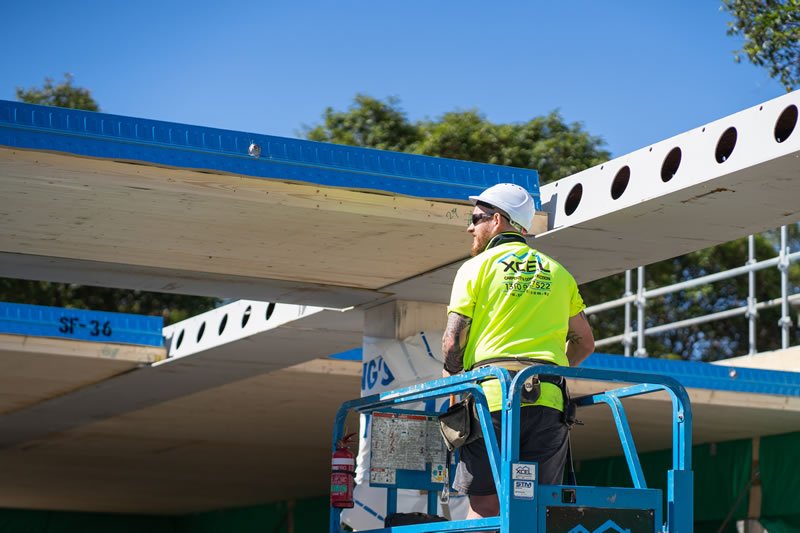A mixed-material approach has helped Viridi Group to win big contracts and can also be the key to smaller fabricators expanding what they can offer to a hungry market.
Oakhill College’s Innovation Hub will, when finished, be a 4200m2 timber and glass structure housing the school’s science and technology facilities. It’s a fairly big build, and one that involves some clever technical responses. But, says Nick Hewson, Viridi Group’s chief design officer and head of product development, while this specific job might require a company like Viridi to realise it, there are lessons here that most timber fabricators can use to increase their business.
“The core difference with the Viridi proposal compared to some of the others tendering for this project was the complete package they were offering,” says Hewson. “Viridi became a one-stop shop for much of the build.”
This argument for stepping into a more central role is something Hewson will be talking about at the upcoming Timber Offsite Construction event and which he sees as a way for more timber fabricators to compete successfully against steel and concrete.
Landing the gig
From the start, the school was adamant it wanted a timber building. MostynCopper was engaged as the lead project manager and went out to the market with an early contractor involvement (ECI) approach. “They understood that sort of process was going to be the best way to get the result they wanted for their project,” Hewson says.
The early schematic design focused strongly on glulam and CLT. “What the Viridi team was able to offer was the mass timber components the client wanted as well as prefabricated lightweight wall cassettes and prefabricated roof cassettes,” says Hewson.
“On top of that, they replaced the CLT floor with our new Strongfloor composite floor system and then brought all that together into a single package. And that was what really got the client’s attention and brought us on to the project.”
Replacing the CLT floor was originally proposed to make construction easier for the builder as well as lowering the costs and weight of both the building and materials transport. A happy side effect was that, over the 2020-2022 procurement and build period, the wider mix of materials has been less affected by supply issues than CLT alone.
A proprietary floor system developed by Viridi, the Strongfloor panels start with a layer of glulam. Profiled steel troughs are fabricated on a separate machine and then glued and nailed to the glulam base. The panels, which can span up to 9m, are designed to be used with Deltabeam steel/concrete composite girders (from Peikko).
“We send the Strongfloor panels to site as a unit,” Hewson says. “They’re put into place on the bottom flange of the Deltabeam and then the build team casts the concrete on site. It flows through the troughs and the holes in the beams and ties the whole floor together, providing a really stiff, high performing floor in the final conditions.
“It’s a very thin floor, there are no big beams sitting down below the slab. So it becomes easier to coordinate mechanical ductwork, pipes, cable trays and so on.”
Oakhill is one of the first projects that has used Deltabeam in Australia; Viridi supplied it for the job. “We put ourselves at the centre of the design and coordination effort on the project,” says Hewson. “We’re supplying glulam, some from Europe, some from Gippsland; we’re supplying CLT from XLam; we’re supplying our composite floor system; we’re supplying the structural steelwork in the Deltabeam, and then the pre-clad lightweight walls and then the lightweight roof cassettes as well. I don’t think there’s any other company that could have provided all these through the one business.
“What that’s meant is that our model becomes the single source of truth: we’re coordinating so much of the structure that everything else then hangs off our model. We put a lot of time and resource into the project from an early stage to make that happen.”
Which is not to say Viridi has been alone on the Oakhill build. Architects BVN and structural engineers Northrop brought their own extensive experience with timber design and construction to the project.
“We’ve worked really closely with both of those very experienced teams, on this project and others,” Hewson says.
“And we’ve been able to bring a bit of our own understanding to some of the more difficult parts, like the connections. The interface between the different components is the hardest part to manage.
“Because we’ve got such a variety of materials coming from different suppliers, understanding tolerances and how the things are physically put together on site, and then trying to develop connections between all of those, has been probably one of the biggest design challenges, especially with new materials like the floor system and the Deltabeam. To their credit, all the members of the design team have been up for the challenge of working through the details together.”
Mixed materials
Adam Strong, Viridi Group’s CEO, has had a longstanding association with CLT but recent projects have more often seen a mixed material response, whether that’s because of fire, vibration or acoustic requirements, or because the builder is less confident with mass timber construction.
Hewson explains that the Strongfloor system was developed as a happy medium: it brings more timber back into the build, but in a way that is easy for a traditional builder to manage. “Adam’s had this product in mind for a number of years and we’ve finally been able to develop and test it and bring it to market,” says Hewson. “It celebrates the timber but is also aware of some of its limitations. The hybrid materials deal neatly with a lot of the design and regulatory issues we see in buildings: fire, acoustics or the structural feel of the floor.
“It’s a bit of a gateway drug to mass timber. While the Oakhill team understood timber well, other clients like the idea of timber, they want to see it in their builds and address their embodied carbon, but they’re not quite ready to go to a full mass timber building or they have a technical challenge around something like fire. This is a kind of happy halfway house for those clients.”
In the long term, Hewson hopes to see the Strongfloor system used in the types of big inner city office projects that are built fairly conventionally at the moment. He says, “It’s rare to get pure CLT floors into those for a number of reasons, mainly fire and structural performance, but we might be able to get a Strongfloor in, because it’s easier for fire engineers and clients to understand.”
This flexibility in materials has become a core Viridi Group design response. “We’re trying to build a broad range of products and solutions into our offer,” Hewson says. “CLT and glulam are wonderful materials, but can be expensive for particular applications. By adding lightweight-framed solutions and composite materials, we can have a wide range of solutions, which means we can be more cost-effective. Bringing all these together through the one supplier means we reduce the risk of coordination issues.”
Lessons from the college
Hewson describes this coordination role as something many fabricators could profitably take on. “That work is complex and time consuming and needs a lot of skilled resource,” he says. “But for the fabricator, you can start with small steps. If you’re a lightweight framing manufacturer, what else can you offer? Maybe ask yourself: ‘How would we put building wrap on? How would we do battens or cladding? What more can we add to make us more integrated and take more work off site, take more of the unknowns out of a project and start to offer solutions to clients?”
Not only does taking those extra steps provide additional income streams, it differentiates a business from its competitors.
“I don’t think the building would have been built in the same combination of materials by any other business,” says Hewson. “The builder would be unlikely to have taken on the coordination across all these different solutions on their own, and the project needed people familiar with the construction of timber buildings to bridge between the two parts of the timber industry – mass timber and lightweight. Everyone’s worried they’re going to lose market share to the other. But actually, you’re going to end up with a much better, more cost-effective solution if you can combine the best parts of both into a single building.
“For example, for lower-rise buildings like hotels or barracks, a great option would be a combination of lightweight timber-framed walls and CLT floors. This offers a great balance between performance and economics and we’ve recently secured several buildings using this combination.”
The real competition remains traditional concrete and steel builders, Hewson says: “They’re taking on a lot of the risks and design responsibilities. For a concrete-frame building, the main contractor tells his subcontractors, ‘I’ve got a concrete frame, here are the drawings, give me a price.’ And then he picks one and they offer the rest.
“We’re still struggling a bit here. One company will supply the CLT, but someone else will supply the glulam and someone else has to design the fixings and someone else has to install it. The builders and the clients look at it and say, ‘Well, in concrete, I just had to speak to one person; here, I’m dealing with four or five different businesses.’”
Hewson believes there are a lot of opportunities for businesses to form collaborations between complementary parties and go in together on a project with an offering that’s the equivalent of what the steel and concrete sectors provide. And while he still loves CLT, he points out that it can be over-engineered for some lower-loaded applications. As at Oakhill, it can at times be partially or wholly replaced with other timber-based materials.
“If you can swap out a CLT wall panel for a lightweight framing wall, but you pre-panelise that with some insulation and cladding before you send it to site, it’s going to give your client a more cost-effective building and still be faster to install. Ultimately, the more we can do that, the more timber we can get into more projects because we can be more cost effective.”
Meanwhile, work on the three-storey Innovation Hub is complete for the lower ground and ground floors, and Hewson expects to be at roof level in two or three months. As with every build, there have been lessons learned, some unexpected.
“On the BIM front, we’ve got a very sophisticated 3D model, which has a lot of information embedded in it in terms of materials, grades, suppliers and so on,” he says. “It’s about 1GB, which is pretty unheard of. Because we’re in control of so much of this build, it’s been easier for us to set that up. Normally to get a project to this sort of scale, you’d have multitudes of different suppliers and consultants and trying to federate those models to be in the same sort of format with the same information is a borderline impossible task in many ways.”
While he thinks the industry has started down the road to using BIM models well, Hewson readily admits there’s a long way left to go. “There’s a lot more opportunity to integrate that information and then make use of it,” he says.
“It’s all well and good putting all that information into a model – which takes a lot of time, resources and money. What do you do with it once it’s there? There’s a value proposition we’re still missing at the moment. Once the building’s ready, how does this data help us maintain it? How do we utilise all this data and make it work for us and for the people who will own or work or live in that building?”
Nick Hewson will talk about Oakhill College as part of Building Project panel Session 3 at Timber Offsite Construction, held 21–22 June online and at the Crown Promenade, Melbourne. For more details, visit www.timberoffsiteconstruction.com
Image: The Strongfloor and Deltabeam combination delivers thin, robust floors that can fit with walls made of light or mass timber, or other materials. Photo courtesy Viridi.












